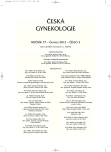Peripartal hysterectomy – review
Authors:
E. Pálová; M. Borovský
Authors place of work:
I. gynekologicko-pôrodnícka klinika LF UK a UNB Bratislava, prednosta prof. MUDr. M. Borovský, CSc.
Published in the journal:
Ceska Gynekol 2012; 77(3): 229-232
Summary
Peripartal hysterectomy is one of the life – threatening procedures needed to be performed in an urgent situation. Women at highest risk of peripartal hysterectomy are multiparas, women who had a caesarian delivery in either previous or present pregnancy or women who had an abnormal placentation. This report presents the basic issues and brief review of the major indications of peripartal hysterectomy. It also compares the effectiveness of the selected types of operation.
Key words:
peripartal hysterectomy, frequency, indications, risk factors.
Zdroje
1. Babinszki, A., Kerenyi, T., Torok, O., et al. Perinatal outcome in grand and great – grand multiparity: effects of parity on obstetric risk factors. Am J Obstet Gynecol, 1999, 181, p. 669–674.
2. Barclay, DL. Cesarean hysterectomy. Obstet Gynecol, 1970, 35, p. 120–131.
3. Clark, SL., Koonings, PP., Phelan, JP. Placenta praevia/accreta and prior cesarean section. Obstet Gynecol, 1985, 66, p. 89–92.
4. Ecker, JL., Frigoletto, FD. Cesarean delivery and the risk – benefit calculus. N Engl J Med, 2007, 356, p. 885–888.
5. Francois, K., Ortiz, J., Harris, C., et al. Is peripartum hysterectomy more common in multiple gestations? Am J Obstet Gynecol, 2005, 105, p. 1369–1372.
6. Glaze, S., Ekwalanga, P., Roberts, G., et al. Peripartum hysterectomy: 1999 to 2006. Obstet Gynecol, 2008, 111, p. 732–738.
7. Chestnut, DH., Eden, RD., Gall, SA., et al. Peripartum hysterectomy: A review of cesarean and postpartum hysterectomy. Obstet Gynecol, 1985, 65, p. 365–370.
8. Kacmar, J., Bhimani, L., Boyd, M., et al. Route of delivery as a risk factor for emergent peripartum hysterectomy: a case-control study 2003, 102, p. 141–145.
9. Kastner, ES., Figueroa, R., Garry, D., et al. Emergency peripartum hysterectomy: Experience at a community teaching hospital. Obstet Gynecol, 2002, 99, p. 971–975.
10. Knight, M. Peripartum hysterectomy in the UK: Management and outcomes of the associated haemorrhage. Br J Obstet Gynecol, 2007, 114, p. 1380–1387.
11. Korbeľ, M., Borovský, M., Danko, J., et al. Analýza perinatologických výsledkov Slovenskej republiky v rokoch 2007–2009. Čes Gynek, 2011, 76, s. 18–24.
12. Kwee, A., Bots, ML.,Visser, GHA., Bruinse, HW. Emergency peripartum hysterectomy: a prospective study in the Netherlands. Eur J Obstet Gynecol Reprod Biol, 2006, 124, p. 187–192.
13. Lombaard, H., Pattinson, RC. Common errors and remedies in managing postpartum hemorrhage. Best Pract Res Clin Obstet Gynecol, 2009, 23, p. 317–326.
14. Mlynček, M., Kellner, M., Uharček, P. Peripartálne hysterektómie – audit na Slovensku v roku 2007. Čes Gynek, 2010, 75, s. 88–92.
15. Pare, E., Quinones, JN., Macones, GA. Vaginal birth after caesarean section versus elective repeat caesarean section: Assessment of maternal downstream health outcomes. BJOG, 2006, 113, p. 75–85.
16. Rossi, AC., Lee, RH., Chmait, RH. Emergency postpartum hysterectomy for uncontrolled postpartum bleeding: a systematic review. Obstet Gynecol, 2000, 115, p. 637.
17. Shah, M., Wright, JD. Surgical Intervention in the management of postpartum hemorrhage. Obstetric Hemorrhage, 2009, 33, p. 109–115.
18. Shellhaas, SC., Gilbert, S., Landon, MB., et al. The frequency and complication rates of hysterectomy accompanying cesarean delivery. Obstet Gynecol, 2009, 114, p. 224–229.
19. Silver, RM., Landon, MB., Rouse, DJ., et al. Maternal morbidity associated with multiple repeat cesarean deliveries. Obstet Gynecol, 2006, 107, p. 1226.
20. Stanco, LM., Schrimmer, DH., Paul, RH., et al. Emergency peripartum hysterectomy and associated risk factors. Am J Obstet Gynecol, 1993, 168, p. 879–883.
21. Thonet, RGN. Obstetric hysterectomy – an 11-years experience. Brit J Obstet Gynecol, 1986, 93, p. 794–798.
22. Turner, MJ. Peripartum hysterectomy: An evolving Picture. I. J Gynecol Obstet, 2010, 109, p. 9–11.
23. Usta, IM., Hobeika, EM., Abu Musa, AA., et al. Placenta previa-accreta: Risk factors and complications. Am J Obstet Gynecol, 2005, 193, p. 1045.
24. World Health Organization. Recommendations for the Prevention of Postpartum Hemorrhage. Geneva. WHO 2007.
25. EURO-PERISTAT Project, with SCPE, EUROCAT, EURONEOSTAT. European perinatal health report: 2008. Available at: http://www.europeristat.com
26. Yucel, O., Ozdemir, I., Yucel, N., et al. Emergency peripartum hysterectomy: a 9-year review. Arch Gynecol Obstet, 2006, 274, p. 84–87.
27. Wright, JD., Devine, P., Shah, M., et al. Morbidity and mortality of peripartum hysterectomy. Obstet Gynecol, 2010, 115, p. 1187.
Štítky
Dětská gynekologie Gynekologie a porodnictví Reprodukční medicínaČlánek vyšel v časopise
Česká gynekologie

2012 Číslo 3
- Primární prevence osteoporózy v kostce
- Horní limit denní dávky vitaminu D: Jaké množství je ještě bezpečné?
- Dlouhodobé užívání dienogestu v terapii endometriózy
- Isoprinosin je bezpečný a účinný v léčbě pacientů s akutní respirační virovou infekcí
- Moje zkušenosti s Magnosolvem podávaným pacientům jako profylaxe migrény a u pacientů s diagnostikovanou spazmofilní tetanií i při normomagnezémii - MUDr. Dana Pecharová, neurolog
Nejčtenější v tomto čísle
- Nová kolposkopická nomenklatura
- Vliv oxidačního stresu na mužskou plodnost
- Peripartálna hysterektómia – review
- Vliv věku rodičky, parity, délky trvání těhotenství a hmotnosti plodu na fetomaternální hemoragii při spontánním porodu
